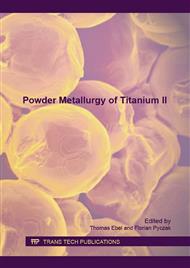p.75
p.85
p.94
p.107
p.113
p.118
p.122
p.130
p.139
Sintering Powder Metal Injection Molded (MIM) Titanium Alloys: In Vacuum or Argon?
Abstract:
Titanium alloys processed by the powder metallurgy route (PM) are sintered in vacuum, the higher the better. This philosophy is carried over to MIM titanium alloys. In the MIM process a large amount of out gassing of binders takes place, which affects the vacuum level and hence the interstitial element pick up in the titanium. In this paper the effect of gaseous material in vacuum is discussed and an alternate method of debinding and sintering in argon is proposed. Three processing conditions are applied to MIM tensile bars made from Ti-6-4 materials. First they are debound and sintered under high vacuum, second debound under argon and sintered in high vacuum and third debound and sintered in flowing argon. The physical properties and interstitial element contents are presented and the effects of the material structures due to different processing on the properties are discussed.
Info:
Periodical:
Pages:
113-117
Citation:
Online since:
August 2016
Authors:
Price:
Сopyright:
© 2016 Trans Tech Publications Ltd. All Rights Reserved
Share:
Citation:


